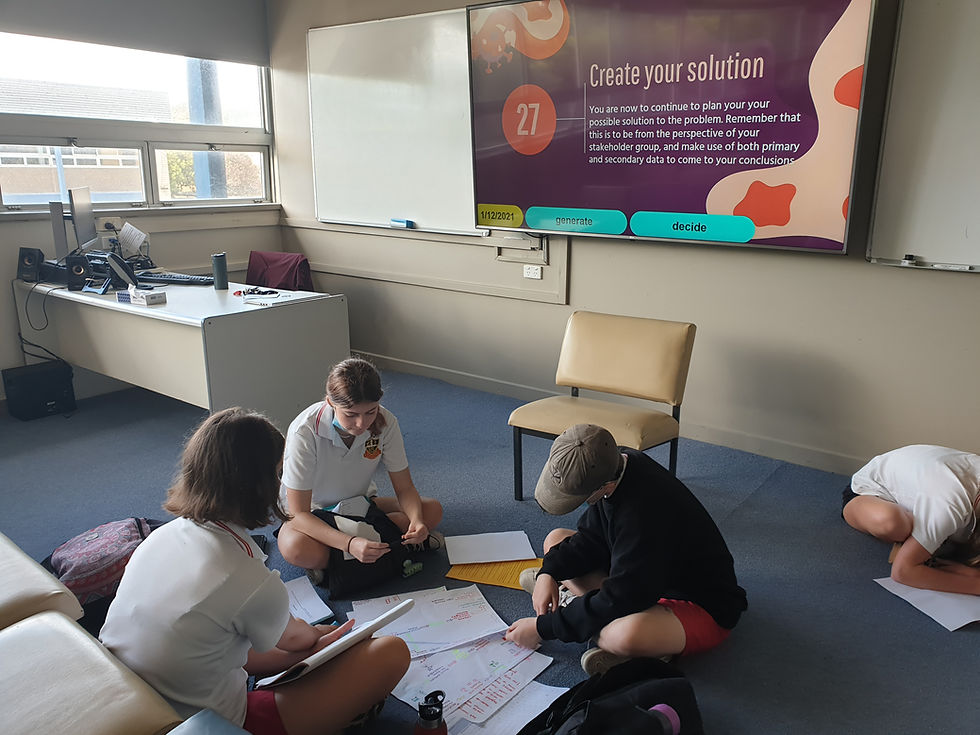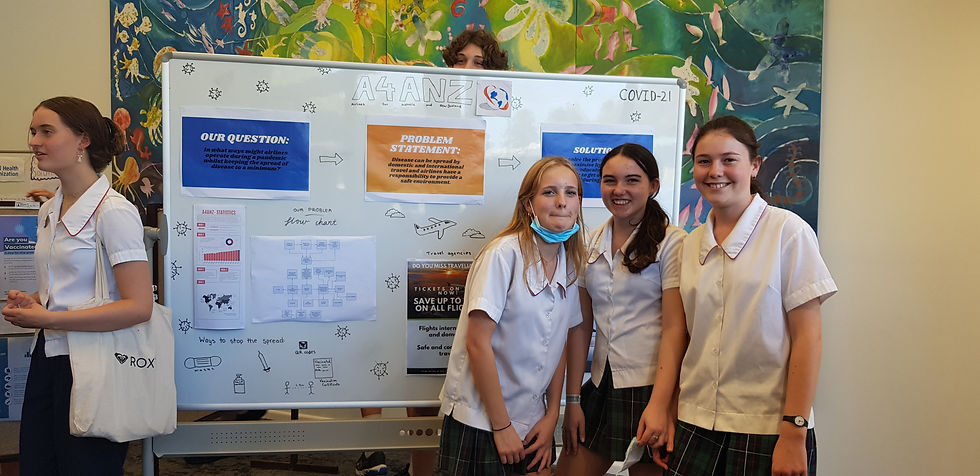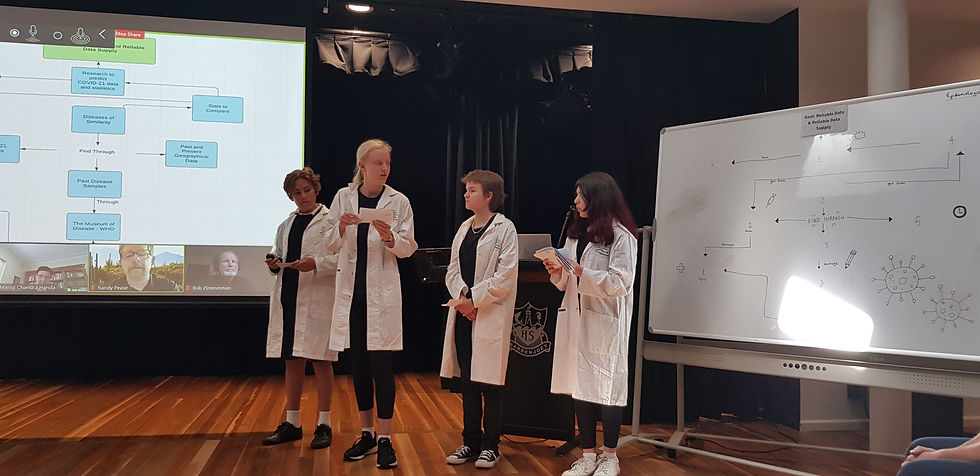Sydney, Australia's Barrenjoey High School Students: Real Engagement in Active Problem Solving
- Website Administrator

- Apr 8, 2022
- 6 min read
Milena Driscoll, Head Teacher Science
Bin Karaolis, Jamie Holmes, Violette Russell, Edward Latham - Student Blog Contributors

In 2021 the Science and HSIE faculties were given a unique opportunity to participate in Real Engagement in Active Problem Solving (REAPS). We were lucky enough to be mentored through this process by two highly influential and successful educational leaders Professor June Maker and Mr Randy Pease. In addition, Dr Robert Zimmerman led us through the process of scoring and gave critical feedback throughout our learning. We were invested in this program as it was an evidence-based initiative which would aim at developing individual student talent. Fostering a passion in education and lifelong learning, REAPS was an invaluable program that promoted critical and creative thinking, collaboration, and a real-life connected experience for our Barrenjoey High School students. Barrenjoey High School is a co-educational High School in the Northern Beaches of Sydney, Australia. We have a diverse range of learners and a dedicated teaching staff. We selected 53 students from Year 9 to take part in this initiative and the project was facilitated across Science and History faculties by a team of seven teachers.
REAPs allowed students to engage in their learning and develop complex relationships within their stakeholder groups. The experience for the teachers was invaluable. It promoted collaboration, collegiality, and most importantly the incorporation of DISCOVER, TASC and PBL to promote creative and critical thinkers. The TASC model allowed our students to generate ideas and then make decisions to solve their own problems.
The project was highly successful, and the students gained improved confidence and a real perspective on the complexity and importance of successful problem-solving.
Concept maps were used and allowed for effective assessment for learning as well as assessment as learning. Evidence demonstrated that students were able to identify concepts and arrange them in a
hierarchy and establish the interconnection between all the critical elements.

We used pre and post-concept maps to measure student growth in the student’s understanding of the relationships of all of the interdisciplinary concepts.
This is an example of a pre concept map
The problem presented to our Year 9 students was: A new disease has emerged in South America. It has quickly spread through community transmission in Brazil and into other parts of South America and has also appeared in North America. The disease is actively spreading much more quickly than expected and has been declared as an epidemic. The World Health Organisation (WHO) is fearful that this epidemic will soon become a pandemic with worldwide spread.

Students were given the opportunity to identify their current level of understanding in the area of disease. Students developed concept maps making connections with the key words and the problem. Students found this challenging but once they engaged in the process it was evident that the students were highly engaged and demonstrated their high order critical thinking skills. To improve the authenticity of this project students went on an excursion to the Human Museum of Disease at the University of Sydney where they engaged with exhibitions and observed specimens and had the opportunity to learn about disease transmission through history.
Following are written testimonials from 4 students who took part in the REAPs program. They were selected from the eleven stakeholder groups who came up with creative and real-world solutions:
Chamber of Commerce - Won-Bin Karaolis
The problem we were given during the REAPS program was how we could deal with the spread of COVID-21 whilst working in favour of our given stakeholder groups. Our group's Stakeholder group was The Avalon & Palm Beach Chamber of Commerce. Our problem-solving process consisted of brainstorming ideas to support local businesses in our area. Then, we began researching other initiatives that were used to support local businesses during the 2020 lockdown. Our finished set of ideas consisted of a voucher similar to Dine and Discover, drone deliveries and PPE at all businesses. The REAPS program allowed us to work with different people and therefore have different angles to the solutions we came up with and presented. Many of our ideas were inspired by strategies applied during the 2020 COVID-19 lockdown, and helped us find out what strategies were effective at safely supporting businesses and what were not.
Airlines - Jamie Holmes
Reaps is a great program in which I learned quite a lot of valuable information as well as lifelong skills of problem-solving, team cooperation, research and comprehension. Our reaps program entailed a problem situation with real-world values of disease prevention and epidemic/pandemic control for a stakeholder group in which you had to resolve and come up with different strategies with a team.

My stakeholder group was representing A4ANZ or Airlines for Australia New Zealand. We had to learn to use our skills of problem-solving and communication to work together and come up with a viable solution for the airline, air travel and air transportation companies in Australia/New Zealand command during the event of an epidemic or pandemic. My group came up with many ideas and solutions for ways airlines could resolve any problems even after experiencing a lockdown of our own including social distancing practices as well as sanitary measures in airports before and after the departure of aircraft. We used research skills and our group managed to get in contact with a pilot who flies internationally for QANTAS and we interviewed him about current regulations for the control of disease in airline companies and worked with him on how we can tweak them to make them more viable and efficient. Reaps has proved a valiant resource in providing me and my peers with skills I can use for a lifetime and especially during my schooling and professional careers.
Epidemiologists - Violette Russell
The REAPS experience was unique and provided an opportunity to view both the figmented pandemic and the current one through a scientific lens. Through the guise of an epidemiologist, my group and I learned about what exactly classifies a pandemic, and all the different ways with which to solve it. Contrary to some beliefs, it is not a simple process and requires the input and collaboration of many different groups with differing perspectives, which helps contribute to our coherent understanding of what a solution needs. From the very beginning, we faced challenges, completing our tasks in record time, not a day going by where we didn’t have to spend time on the project.

From there we had a fun (and freaky) tour through the UNSW Museum of Human Disease (above picture), seeing many weird and wonderful donations depicting all the ways in which a pathogen could affect you. One thing led to another and we were presenting in front of strangers, wearing our borrowed science coats and pretending we knew what we were talking about. I developed a new empathy for the poor Medical Officers on the news, it was certainly a nerve-wracking experience. All in all, there was something learned, and something gained, the REAPS project is not one to be forgotten anytime soon.
Nurse Association - Edward Latham
During the REAPS program, we were introduced to a new disease similar to COVID-19 and given the task of finding the best possible responses from a given stakeholder group. My stakeholder group was the New South Wales Nurses and Midwives Association. We approached this task with an idea of providing increased resources and funding in hospitals to protect nurses and midwives and allow them to keep doing their jobs. There were a few steps in our problem-solving process. The first of these was to brainstorm and get as much information and ideas as we could down. Within our group we would all try to contribute as many ideas as we can in a map with little filter to what we put down. After that we put our ideas from the mind map into a table that scored and ranked the ideas on criteria such as ‘real world practicality’ and ‘cost effectiveness’ to try and find the best of our original ideas. Following this, we tried to narrow down ideas more and find what was common between them to find our main, general idea. Once we had our main idea as well as our different solutions, we researched each one individually within our groups and put together a presentation on each aspect of our idea to show to a board of experts.

My group, the NSWNMA, looked at funding for hospitals for a few main things. These included: mental health services for nurses struggling with longer hours, more funding for ventilators, funding for PPE and testing for nurses and patients entering hospitals and priority for nurses to get vaccinated.

Students presenting their solution to the problem as the Nurse Association Stakeholder Group



Comments